| Listing 1 - 9 of 9 |
Sort by
|
Book
ISBN: 0262120801 9780262120807 Year: 1979 Publisher: Cambridge, Mass. : MIT Press,
Abstract | Keywords | Export | Availability | Bookmark
 Loading...
Loading...Choose an application
- Reference Manager
- EndNote
- RefWorks (Direct export to RefWorks)
Maximum entropy method --- Congresses --- Congresses. --- -519.72 --- Entropy maximization --- Entropy maximum principle --- Maximization, Entropy --- Entropy (Information theory) --- Maximum principles (Mathematics) --- Information theory: mathematical aspects --- Conferences - Meetings --- 519.72 Information theory: mathematical aspects --- 519.72 --- Maximum entropy method - Congresses
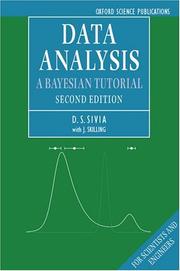
ISBN: 128134138X 0191546704 9780191546709 9786611341381 6611341382 9780198568315 0198568312 0198568320 9780198568322 1383029814 Year: 2023 Publisher: Oxford : Oxford University Press,
Abstract | Keywords | Export | Availability | Bookmark
 Loading...
Loading...Choose an application
- Reference Manager
- EndNote
- RefWorks (Direct export to RefWorks)
Focusing on Bayesian methods and maximum entropy, this book shows how a few fundamental rules can be used to tackle a variety of problems in data analysis. Topics covered include reliability analysis, multivariate optimisation, least-squares and maximum likelihood, and more.
Maximum entropy method. --- Maximum principles (Mathematics) --- Engineering mathematics. --- Science --- Engineering --- Engineering analysis --- Mathematical analysis --- Differential equations, Partial --- Entropy maximization --- Entropy maximum principle --- Maximization, Entropy --- Entropy (Information theory) --- Mathematics. --- Mathematics --- Numerical solutions
Book
ISBN: 3110550768 311055044X 3110550431 Year: 2017 Publisher: De Gruyter
Abstract | Keywords | Export | Availability | Bookmark
 Loading...
Loading...Choose an application
- Reference Manager
- EndNote
- RefWorks (Direct export to RefWorks)
Non-extensive Entropy Econometrics for Low Frequency Series provides a new and robust power-law-based, non-extensive entropy econometrics approach to the economic modelling of ill-behaved inverse problems. Particular attention is paid to national account-based general equilibrium models known for their relative complexity.In theoretical terms, the approach generalizes Gibbs-Shannon-Golan entropy models, which are useful for describing ergodic phenomena. In essence, this entropy econometrics approach constitutes a junction of two distinct concepts: Jayne's maximum entropy principle and the Bayesian generalized method of moments. Rival econometric techniques are not conceptually adapted to solving complex inverse problems or are seriously limited when it comes to practical implementation. Recent literature showed that amplitude and frequency of macroeconomic fluctuations do not substantially diverge from many other extreme events, natural or human-related, once they are explained in the same time (or space) scale. Non-extensive entropy is a precious device for econometric modelling even in the case of low frequency series, since outputs evolving within the Gaussian attractor correspond to the Tsallis entropy limiting case of Tsallis q-parameter around unity. This book introduces a sub-discipline called Non-extensive Entropy Econometrics or, using a recent expression, Superstar Generalised Econometrics. It demonstrates, using national accounts-based models, that this approach facilitates solving nonlinear, complex inverse problems, previously considered intractable, such as the constant elasticity of substitution class of functions. This new proposed approach could extend the frontier of theoretical and applied econometrics.
Business cycles. --- Econometrics. --- Maximum entropy method. --- generalized cross-entropy, general equilibrium macro-economic model, econometrics. --- BUSINESS & ECONOMICS / Econometrics. --- Entropy maximization --- Entropy maximum principle --- Maximization, Entropy --- Entropy (Information theory) --- Maximum principles (Mathematics) --- Economics, Mathematical --- Statistics --- Economic cycles --- Economic fluctuations --- Cycles
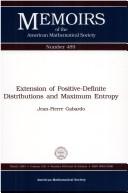
ISBN: 0821825518 Year: 1993 Publisher: Providence (R.I.): American Mathematical Society
Abstract | Keywords | Export | Availability | Bookmark
 Loading...
Loading...Choose an application
- Reference Manager
- EndNote
- RefWorks (Direct export to RefWorks)
Ergodic theory. Information theory --- Mathematical distribution theory --- Fourier analysis --- Maximum entropy method --- Positive-definite functions --- Distributions, Positive-definite --- Positive-definite distributions --- Functions --- Entropy maximization --- Entropy maximum principle --- Maximization, Entropy --- Entropy (Information theory) --- Maximum principles (Mathematics) --- Analysis, Fourier --- Mathematical analysis --- Functions, Continuous --- Fonctions continues --- Entropie maximale, Méthode d' --- Fourier, Analyse de --- Fonctions continues. --- Entropie maximale, Méthode d'. --- Fourier, Analyse de.
Book
ISBN: 3031130774 3031130782 Year: 2022 Publisher: Cham, Switzerland : Springer,
Abstract | Keywords | Export | Availability | Bookmark
 Loading...
Loading...Choose an application
- Reference Manager
- EndNote
- RefWorks (Direct export to RefWorks)
Mathematical optimization. --- Maximum entropy method. --- Mathematical optimization --- Optimització matemàtica --- Methodology. --- Mètodes de simulació --- Jocs d'estratègia (Matemàtica) --- Optimització combinatòria --- Programació dinàmica --- Programació (Matemàtica) --- Anàlisi de sistemes --- Optimization (Mathematics) --- Optimization techniques --- Optimization theory --- Systems optimization --- Mathematical analysis --- Maxima and minima --- Operations research --- Simulation methods --- System analysis --- Entropy maximization --- Entropy maximum principle --- Maximization, Entropy --- Entropy (Information theory) --- Maximum principles (Mathematics)
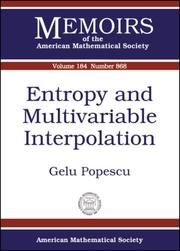
ISBN: 9780821839126 0821839128 Year: 2006 Publisher: Providence American Mathematical Society
Abstract | Keywords | Export | Availability | Bookmark
 Loading...
Loading...Choose an application
- Reference Manager
- EndNote
- RefWorks (Direct export to RefWorks)
Operator theory --- 517.518 --- 51 <082.1> --- Metric theory of functions --- Mathematics--Series --- 517.518 Metric theory of functions --- Interpolation --- Linear operators --- Maximum entropy method --- Interpolation (mathématiques) --- Opérateurs linéaires --- Entropie maximale, Méthode d' --- Opérateurs, Théorie des --- Functional analysis --- Entropy maximization --- Entropy maximum principle --- Maximization, Entropy --- Entropy (Information theory) --- Maximum principles (Mathematics) --- Linear maps --- Maps, Linear --- Operators, Linear --- Approximation theory --- Numerical analysis --- Opérateurs linéaires. --- Entropie maximale, Méthode d'. --- Opérateurs, Théorie des.
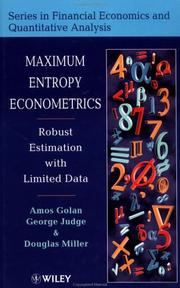
ISBN: 0471953113 9780471953111 Year: 1996 Publisher: New York, NY : John Wiley,
Abstract | Keywords | Export | Availability | Bookmark
 Loading...
Loading...Choose an application
- Reference Manager
- EndNote
- RefWorks (Direct export to RefWorks)
Mathematical statistics --- Quantitative methods (economics) --- Econometrics. --- Maximum entropy method. --- Estimation theory. --- Econométrie --- Théorie de l'estimation --- 330.115 --- Econometrics --- Estimation theory --- Maximum entropy method --- Entropy maximization --- Entropy maximum principle --- Maximization, Entropy --- Entropy (Information theory) --- Maximum principles (Mathematics) --- Estimating techniques --- Least squares --- Stochastic processes --- Economics, Mathematical --- Statistics --- Econometrie --- Social Sciences and Humanities. Economics --- 330.115 Econometrie --- Econométrie --- Théorie de l'estimation --- Économétrie. --- Entropie maximale, Méthode d'. --- Estimation, Théorie de l'.
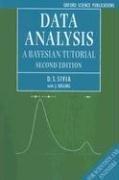
ISBN: 9780198568322 9780198568315 0198568320 0198568312 Year: 2006 Publisher: Oxford : Oxford University Press,
Abstract | Keywords | Export | Availability | Bookmark
 Loading...
Loading...Choose an application
- Reference Manager
- EndNote
- RefWorks (Direct export to RefWorks)
Stochastic processes --- Mathematical statistics --- Bayesian statistical decision theory --- Maximum entropy method --- Bayesian statistical decision theory. --- Maximum entropy method. --- Statistique bayésienne --- Entropie maximale, Méthode d' --- 519.5 --- Entropy maximization --- Entropy maximum principle --- Maximization, Entropy --- Entropy (Information theory) --- Maximum principles (Mathematics) --- Bayes' solution --- Bayesian analysis --- Statistical decision --- Engineering mathematics --- Science --- Principes du maximum (Mathématiques) --- Mathématiques de l'ingénieur --- Sciences --- Mathematics --- Mathématiques --- Statistique bayésienne. --- Entropie maximale, Méthode d'. --- 519.24 --- 519.24 Special statistical applications and models --- Special statistical applications and models
Book
ISBN: 3319694383 3319694367 Year: 2017 Publisher: Cham : Springer International Publishing : Imprint: Springer,
Abstract | Keywords | Export | Availability | Bookmark
 Loading...
Loading...Choose an application
- Reference Manager
- EndNote
- RefWorks (Direct export to RefWorks)
This book is an introduction to maximum-entropy models of random graphs with given topological properties and their applications. Its original contribution is the reformulation of many seemingly different problems in the study of both real networks and graph theory within the unified framework of maximum entropy. Particular emphasis is put on the detection of structural patterns in real networks, on the reconstruction of the properties of networks from partial information, and on the enumeration and sampling of graphs with given properties. After a first introductory chapter explaining the motivation, focus, aim and message of the book, chapter 2 introduces the formal construction of maximum-entropy ensembles of graphs with local topological constraints. Chapter 3 focuses on the problem of pattern detection in real networks and provides a powerful way to disentangle nontrivial higher-order structural features from those that can be traced back to simpler local constraints. Chapter 4 focuses on the problem of network reconstruction and introduces various advanced techniques to reliably infer the topology of a network from partial local information. Chapter 5 is devoted to the reformulation of certain “hard” combinatorial operations, such as the enumeration and unbiased sampling of graphs with given constraints, within a “softened” maximum-entropy framework. A final chapter offers various overarching remarks and take-home messages. By requiring no prior knowledge of network theory, the book targets a broad audience ranging from PhD students approaching these topics for the first time to senior researchers interested in the application of advanced network techniques to their field.
Physics. --- System theory. --- Graph theory. --- Complexity, Computational. --- Applications of Graph Theory and Complex Networks. --- Statistical Physics and Dynamical Systems. --- Complex Systems. --- Graph Theory. --- Complexity. --- Maximum entropy method. --- Entropy maximization --- Entropy maximum principle --- Maximization, Entropy --- Entropy (Information theory) --- Maximum principles (Mathematics) --- Statistical physics. --- Engineering. --- Construction --- Industrial arts --- Technology --- Physics --- Mathematical statistics --- Statistical methods --- Computational complexity. --- Complexity, Computational --- Electronic data processing --- Machine theory --- Graph theory --- Graphs, Theory of --- Theory of graphs --- Combinatorial analysis --- Topology --- Systems, Theory of --- Systems science --- Science --- Natural philosophy --- Philosophy, Natural --- Physical sciences --- Dynamics --- Extremal problems --- Philosophy
| Listing 1 - 9 of 9 |
Sort by
|

 Search
Search Feedback
Feedback About
About Help
Help News
News